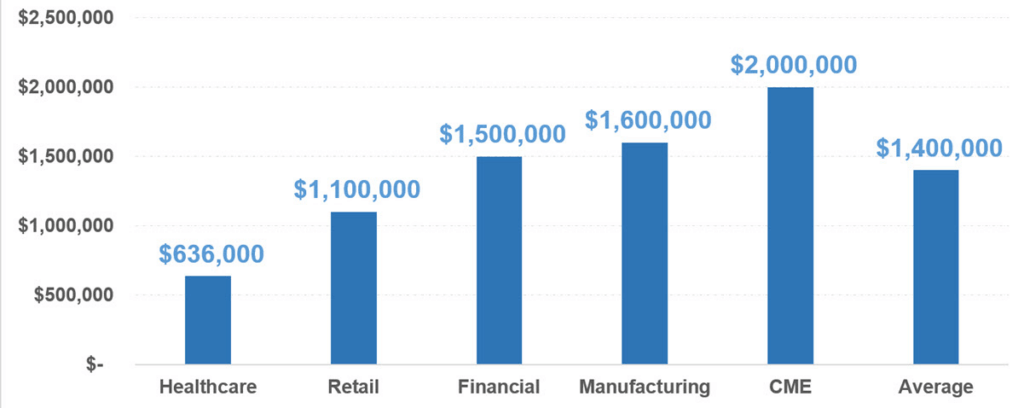- About
- Solutions
- Essentials
- Utilities
- Publications
- Product Delivery
- Support
To realize this advantage, this data must be current and available across the enterprise at all times. Otherwise, the inability to access or update, or the loss of this data carries significant potential business cost: up to thousands of dollars per second loss of brand reputation, regulatory fines, and other unforeseen consequences that could be prevented.

Figure 1 — Average Costs per Hour of Downtime Across Various Industries
(Source: Network Computing, the Meta Group, Contingency Planning Research)
Figure 1 states the numerous costs per hour of downtime by industry (in USD) with an average of $1.4M.
In some cases, absolutely no data loss can be tolerated:
| Technology Architecture | Recovery Point Objective | Retail | Credit/Debit Card | EFT | Stock Trade |
| Active/Passive and Sizzling-Hot-Takeover5 | ~1 sec | $47.5K | $35.6K | $688K | $31.6M |
| Active/Active | ~0.5 sec | $23.8K | $17.8K | $344K | $15.8M |
| Average Transaction Value | N/A | ~$95 (US)1 |
~$71 (UK)2 |
~$1,376 (Canada)3 |
~$63,284 (UK)4 |
| *I.E., 500 transactions per second 1Source: Monetate 2Source: European Central Bank 3Source: Canadian Payments Association 4Source: London Stock Exchange 5Asynchronous replication |
|||||
Most other data replication software uses asynchronous replication that leads to the possibility of data loss for unplanned outages. For this reason, companies must consider a zero data loss solution to protect their invaluable data. Shadowbase ZDL guarantees that all committed data changes made on one system are replicated to a backup system. Therefore, unplanned system outages never result in lost data, and the business will never face these costs or the headache of trying to recover lost data.
Shadowbase ZDL uses synchronous replication, which avoids data loss for active/passive architectures, and eliminates all possibility of data loss, as explained in these definitions:
| Attribute | Asynchronous Active/Passive | Synchronous Active/Passive | Asynchronous Sizzling-Hot-Takeover | Synchronous Sizzling-Hot-Takeover | Asynchronous Active/Active | Synchronous Active/Active |
| Failover Faults | Yes | Yes | No | No | No | No |
| Backup Utilized | No3 | No3 | No | No | Yes | Yes |
| Data Collisions | Not possible | Not possible | Not possible | Not Possible | Possible | Possible4 |
| Data/Request Partitioning | Not required2 | Not required2 | Not required | Not Required | Possible | Possible |
| Application Outage | Yes | Yes | Minimal1 | Minimal1 | No | No |
| Data Loss | Yes | None | Yes | None | Yes | None |
| 1All users affected, but takeover time is the same as Active/Active modes. 2“Required” if run in Reciprocal Mode. (Reciprocal Mode allows each system to be active for a separate data set.) 3“Yes” if run in Reciprocal Mode. 4Collisions may be avoided in both asynchronous and synchronous architectures by using a partitioned database or data-dependent routing. |
||||||
Use Shadowbase ZDL to significantly reduce outage costs by avoiding data loss. Shadowbase ZDL is the pinnacle of replication solutions for business continuity and data integration, providing the ultimate protection level against unplanned service outage costs.
Shadowbase ZDL product licensing requires application prequalification. Specifications are subject to change without notice, and delivery dates/timeframes are not guaranteed. Purchasing decisions should not be made based on this material without first verifying that the desired features are available on the desired platforms and environments.
NOTICE: This product does not guarantee that you will not lose any data; all user warranties are provided solely in accordance with the terms of the product License Agreement. Each user’s experiences will vary depending on its system configuration, hardware and other software compatibility, operator capability, data integrity, user procedures, backups and verification, network integrity, third-party products and services, modifications and updates to this product and others, as well as other factors. Please consult with your supplier and review our License Agreement for more information.